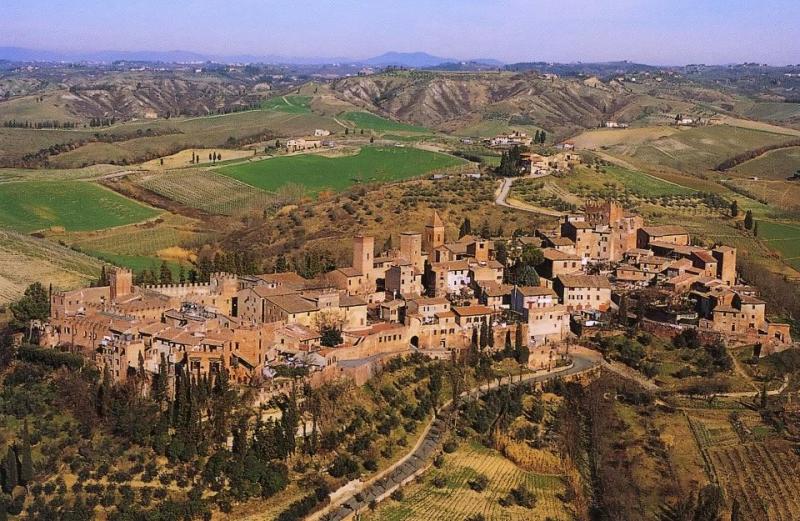Strolling the small alleys of Certaldo, it’s easy to feel transported back to the time when none other than the author of the Decameron, Giovanni Boccaccio, walked the streets of this little medieval village in the heart of the Valdelsa, between Florence and Siena.
Ideal base for exploring major Tuscan attractions like nearby San Gimignano and the Chianti area, Certaldo, entirely built of red bricks and in part still surrounded by walls, shares the beauty of its most famous neighbors, but not the crowds, making it an off-the-beaten-track destination.
Positioned at the top of a hill overlooking the lush valley below, Certaldo can be reached either on foot, climbing up the steep ancient Costa Alberti or Costa Vecchia streets, or by taking the funicular, which connects Certaldo Bassa, the modern town that has developed at the foot of the hill, to Certaldo Alta, in just a couple of minutes.

[Photo: view of Certaldo and Via Boccaccio from the rooftop terrace of Boccaccio's House.]
In medieval villages, the heart of town, where the main authorities of the time - political, judiciary, economic and religious - were represented, was the piazza; but because Certaldo rests on a hill with an irregular shape, no central square could be built there, so the main road traversing the village, now called Via Boccaccio in honor of the little town’s most illustrious son, served the function of the piazza.
In fact, along Via Boccaccio are some of Certaldo’s most significant buildings, including Palazzo Pretorio, the Church of Saints Jacopo and Filippo, the Logge del Mercato (marketplace buildings) and Boccaccio’s House, as well as several ancient noble houses, like the 14th century Palazzo Stiozzi Ridolfi, Palazzo Giannozzi and the casa-torre (house in the shape of a tower) Palazzo Machiavelli. Due to its strategic position along the Via Francigena, Certaldo soon became an important trade route and was home to several families of notable merchants, like those of the Machiavelli and Arena, besides Boccaccio’s own family.
Considered one of the most significant figures in Italian literature, Boccaccio was born in Certaldo in 1313, the son of a Florentine merchant, Messer Boccaccio di Chellino, and a French noblewoman, most likely out of wedlock – or so the legend goes: the details of his birth are uncertain.

[Photo: Certaldo's main road, Via Boccaccio.]
The author and poet returned and lived in Certaldo several times during his lifetime; halfway through Via Boccaccio is the house where he resided (and died in 1375). It is a faithful reconstruction of the original, which was destroyed by a bomb during World War II. The house, which today is a museum, hosts a library dedicated to the life and works of Boccaccio. The interesting museum develops on several levels: of particular interest is “la stanza del Poeta” (room of the poet), with objects and furniture from the 17th century, a display of rare 14th century shoes found during restoration following the bombing, and a large 1826 painting by Pietro Benvenuti, portraying Boccaccio at his desk. Walking all the way up to the rooftop terrace will reward you with a 360° view of the red-brick borgo and the verdant Valdelsa.
Along Via Boccaccio is also the Church of Saints Jacopo and Filippo, where, in the center, is the tomb of Boccaccio covered by a bas relief depicting the poet.

[Photo: the facade of Palazzo Pretorio with the colorful emblems of the Florentine governors' families.]
Certaldo’s “golden age” began in 1415, when it became the seat of the Vicariato, the political and judiciary center for Valdelsa, Val di Pesa and Valdarno under the Florentine Republic and later the Medici. Statement to this is the 12th century Palazzo Pretorio, located right at the end of Via Boccaccio, at the top of the hill. Originally a private residence, it housed the local government, the feared courthouse, the prisons, and the residence of the Vicari, who had full powers over the life and death of the people they controlled. The colorful coats of terracotta and marble belonging to the different families who lived and governed there are still on display on the façade and inside. An exploration of the palace makes for a very evocative visit, especially when entering the prisons (male and female) and the judicial hearing room (the waiting room next to it has inscriptions from those waiting to be judged).
A visit to Certaldo could end by taking Via del Rivellino, Certaldo’s second most important street (to the right of Palazzo Pretorio when standing in front of it), to the Porta del Rivellino, one of the three remaining gates to the town and the most fortified because, right in front of it, was the bordering Republic of Siena – the enemy. From here, looking at the panoramic view of the surrounding valley and back toward the towers and palaces that form the background for Certaldo, you can almost picture Boccaccio and his fellow citizens in the Middle Ages going about their business.

[Photo: Porta del Rivellino, one of the three remaining gates.]
Where to eat
Do not leave Certaldo without trying one of the excellent local restaurants!
I recommend:
Ristorante L’Antica Fonte, Via Valdracca 25 – beautiful panoramic terrace, great atmosphere, great food, from handmade pasta, to cheese and salumi platters to bruschetta (try the one with the famous Cipolla di Certaldo (Certaldo's onion).
Osteria del Vicario, Via Rivellino 3. Housed in a former 13th century monastery, it features an outside courtyard where you can admire the Tuscan countryside while dining on local specialties like the excellent Pici all’aglione.
How to get there
Certaldo is 47 km south-west of Florence. From Florence on the A1, exit Firenze Signa, then take the superstrada Pisa-Livorno, exit Empoli Ovest, take S429 direction Siena.
Save money! The Sistema Museale Certaldo offers the chance to buy one entrance ticket for both the Casa del Boccaccio and Palazzo Pretorio for the price of 4 euros.














